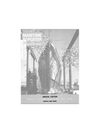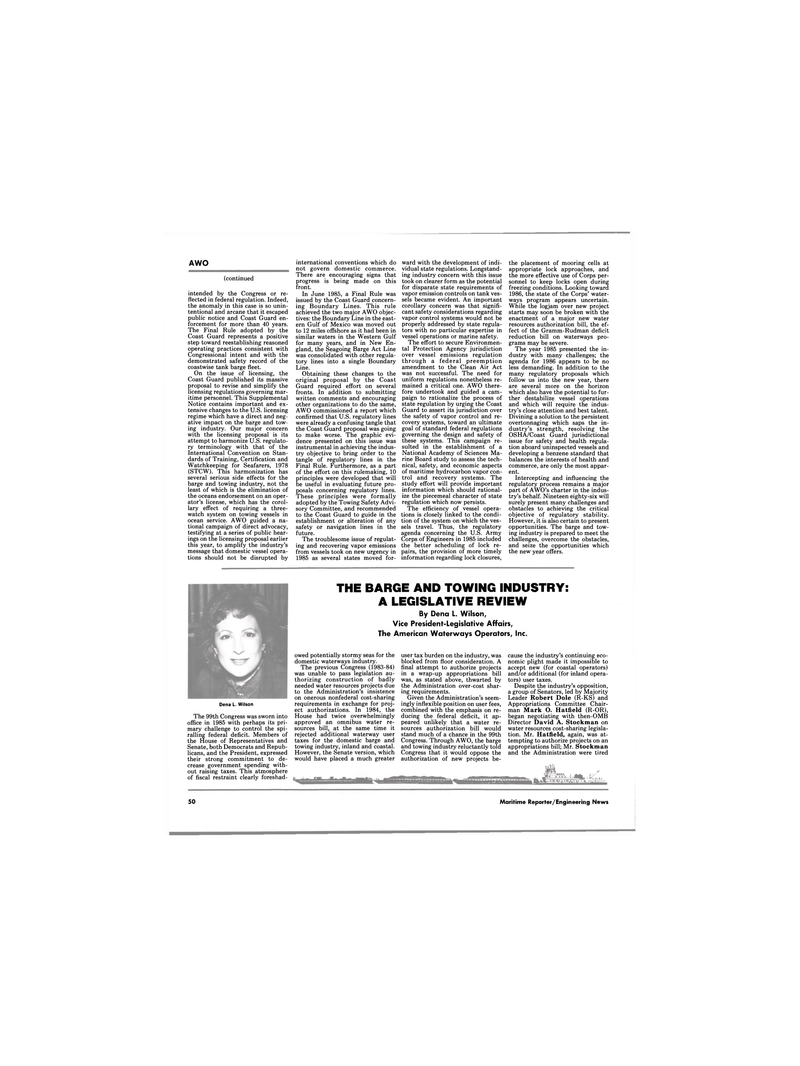
Page 48: of Maritime Reporter Magazine (March 1986)
Read this page in Pdf, Flash or Html5 edition of March 1986 Maritime Reporter Magazine
AWO (continued intended by the Congress or re- flected in federal regulation. Indeed, the anomaly in this case is so unin- tentional and arcane that it escaped public notice and Coast Guard en- forcement for more than 40 years.
The Final Rule adopted by the
Coast Guard represents a positive step toward reestablishing reasoned operating practices consistent with
Congressional intent and with the demonstrated safety record of the coastwise tank barge fleet.
On the issue of licensing, the
Coast Guard published its massive proposal to revise and simplify the licensing regulations governing mar- itime personnel. This Supplemental
Notice contains important and ex- tensive changes to the U.S. licensing regime which have a direct and neg- ative impact on the barge and tow- ing industry. Our major concern with the licensing proposal is its attempt to harmonize U.S. regulato- ry terminology with that of the
International Convention on Stan- dards of Training, Certification and
Watchkeeping for Seafarers, 1978 (STCW). This harmonization has several serious side effects for the barge and towing industry, not the least of which is the elimination of the oceans endorsement on an oper- ator's license, which has the corol- lary effect of requiring a three- watch system on towing vessels in ocean service. AWO guided a na- tional campaign of direct advocacy, testifying at a series of public hear- ings on the licensing proposal earlier this year, to amplify the industry's message that domestic vessel opera- tions should not be disrupted by
VST-
Dena L. Wilson
The 99th Congress was sworn into office in 1985 with perhaps its pri- mary challenge to control the spi- ralling federal deficit. Members of the House of Representatives and
Senate, both Democrats and Repub- licans, and the President, expressed their strong commitment to de- crease government spending with- out raising taxes. This atmosphere of fiscal restraint clearly foreshad- international conventions which do not govern domestic commerce.
There are encouraging signs that progress is being made on this front.
In June 1985, a Final Rule was issued by the Coast Guard concern- ing Boundary Lines. This rule achieved the two major AWO objec- tives: the Boundary Line in the east- ern Gulf of Mexico was moved out to 12 miles offshore as it had been in similar waters in the Western Gulf for many years, and in New En- gland, the Seagoing Barge Act Line was consolidated with other regula- tory lines into a single Boundary
Line.
Obtaining these changes to the original proposal by the Coast
Guard required effort on several fronts. In addition to submitting written comments and encouraging other organizations to do the same,
AWO commissioned a report which confirmed that U.S. regulatory lines were already a confusing tangle that the Coast Guard proposal was going to make worse. The graphic evi- dence presented on this issue was instrumental in achieving the indus- try objective to bring order to the tangle of regulatory lines in the
Final Rule. Furthermore, as a part of the effort on this rulemaking, 10 principles were developed that will be useful in evaluating future pro- posals concerning regulatory lines.
These principles were formally adopted by the Towing Safety Advi- sory Committee, and recommended to the Coast Guard to guide in the establishment or alteration of any safety or navigation lines in the future.
The troublesome issue of regulat- ing and recovering vapor emissions from vessels took on new urgency in 1985 as several states moved for- owed potentially stormy seas for the domestic waterways industry.
The previous Congress (1983-84) was unable to pass legislation au- thorizing construction of badly needed water resources projects due to the Administration's insistence on onerous nonfederal cost-sharing requirements in exchange for proj- ect authorizations. In 1984, the
House had twice overwhelmingly approved an omnibus water re- sources bill, at the same time it rejected additional waterway user taxes for the domestic barge and towing industry, inland and coastal.
However, the Senate version, which would have placed a much greater ward with the development of indi- vidual state regulations. Longstand- ing industry concern with this issue took on clearer form as the potential for disparate state requirements of vapor emission controls on tank ves- sels became evident. An important corollary concern was that signifi- cant safety considerations regarding vapor control systems would not be properly addressed by state regula- tors with no particular expertise in vessel operations or marine safety.
The effort to secure Environmen- tal Protection Agency jurisdiction over vessel emissions regulation through a federal preemption amendment to the Clean Air Act was not successful. The need for uniform regulations nonetheless re- mained a critical one. AWO there- fore undertook and guided a cam- paign to rationalize the process of state regulation by urging the Coast
Guard to assert its jurisdiction over the safety of vapor control and re- covery systems, toward an ultimate goal of standard federal regulations governing the design and safety of these systems. This campaign re- sulted in the establishment of a
National Academy of Sciences Ma- rine Board study to assess the tech- nical, safety, and economic aspects of maritime hydrocarbon vapor con- trol and recovery systems. The study effort will provide important information which should rational- ize the piecemeal character of state regulation which now persists.
The efficiency of vessel opera- tions is closely linked to the condi- tion of the system on which the ves- sels travel. Thus, the regulatory agenda concerning the U.S. Army
Corps of Engineers in 1985 included the better scheduling of lock re- pairs, the provision of more timely information regarding lock closures, user tax burden on the industry, was blocked from floor consideration. A final attempt to authorize projects in a wrap-up appropriations bill was, as stated above, thwarted by the Administration over-cost shar- ing requirements.
Given the Administration's seem- ingly inflexible position on user fees, combined with the emphasis on re- ducing the federal deficit, it ap- peared unlikely that a water re- sources authorization bill would stand much of a chance in the 99th
Congress. Through AWO, the barge and towing industry reluctantly told
Congress that it would oppose the authorization of new projects be- the placement of mooring cells at appropriate lock approaches, and the more effective use of Corps per- sonnel to keep locks open during freezing conditions. Looking toward 1986, the state of the Corps' water- ways program appears uncertain.
While the logjam over new project starts may soon be broken with the enactment of a major new water resources authorization bill, the ef- fect of the Gramm-Rudman deficit reduction bill on waterways pro- grams may be severe.
The year 1985 presented the in- dustry with many challenges; the agenda for 1986 appears to be no less demanding. In addition to the many regulatory proposals which follow us into the new year, there are several more on the horizon which also have the potential to fur- ther destabilize vessel operations and which will require the indus- try's close attention and best talent.
Divining a solution to the persistent overtonnaging which saps the in- dustry's strength, resolving the
OSHA/Coast Guard jurisdictional issue for safety and health regula- tion aboard uninspected vessels and developing a benzene standard that balances the interests of health and commerce, are only the most appar- ent.
Intercepting and influencing the regulatory process remains a major part of AWO's charter in the indus- try's behalf. Nineteen eighty-six will surely present many challenges and obstacles to achieving the critical objective of regulatory stability.
However, it is also certain to present opportunities. The barge and tow- ing industry is prepared to meet the challenges, overcome the obstacles, and seize the opportunities which the new year offers. cause the industry's continuing eco- nomic plight made it impossible to accept new (for coastal operators) and/or additional (for inland opera- tors) user taxes.
Despite the industry's opposition, a group of Senators, led by Majority
Leader Robert Dole (R-KS) and
Appropriations Committee Chair- man Mark O. Hatfield (R-OR), began negotiating with then-OMB
Director David A. Stockman on water resources cost-sharing legisla- tion. Mr. Hatfield, again, was at- tempting to authorize projects on an appropriations bill; Mr. Stockman and the Administration were tired
THE BARGE AND TOWING INDUSTRY:
A LEGISLATIVE REVIEW
By Dena L. Wilson,
Vice President-Legislative Affairs,
The American Waterways Operators, Inc. 50 Maritime Reporter/Engineering News

 47
47

 49
49
